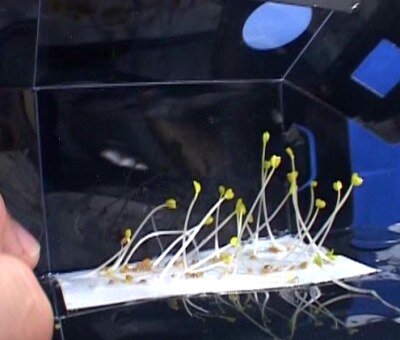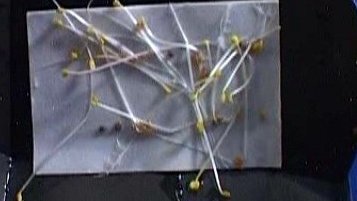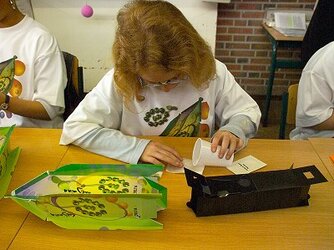PROJECT: Seeds in Space

 Many things that you see in nature seem to be obvious. But are they? Do you understand how seeds that grow in the darkness of the soil ‘know’ in which direction they should develop a sprout? They probably feel gravity and develop a sprout against the direction of this force. But what about the stage of growth when the sprout emerges from the soil surface? Is the top of the little plant attracted by light, or does gravity continue to be the only reference for the growth direction?
Many things that you see in nature seem to be obvious. But are they? Do you understand how seeds that grow in the darkness of the soil ‘know’ in which direction they should develop a sprout? They probably feel gravity and develop a sprout against the direction of this force. But what about the stage of growth when the sprout emerges from the soil surface? Is the top of the little plant attracted by light, or does gravity continue to be the only reference for the growth direction?

To understand the influence of gravity and light on the growing of seeds, we grow lettuce seeds in two different boxes: with and without light. We take the results of the two same experiments done by ESA astronaut Andre Kuipers on board the International Space Station (ISS) during the Delta mission in 2004.
Preparation:
Read the instructions of the experiment and discuss:
- What are we going to examine? (purpose)
- What do we think will happen? (assumption)
- What are we going to change? What are we not going to change
- How and what will we measure?
- What are we going to do?
- How long will the experiment last?
- Will we repeat the experiment?
- How many measurements are we going to take?
Experiment
- Prepare two boxes, preferably from plastic since they will become wet inside. Dimensions are about 15 x 5 x 5 cm. One box should be completely dark, the other is identical with a hole of about 1.5 cm diameter.
- Get fast growing seeds. Seeds in Space originally applied Seeds from rocket lettuce.
- In both boxes, cover one large side with a thin layer of paper tissues.
- Distribute the seeds over these tissues; about 20 seeds will do.
- Add some water. A teaspoon is enough.
- Close the boxes and make sure that the one with the hole has this hole facing upwards.
- Switch the light on and let the light shine through the hole.
- Let the experiment run for four days.
- Every 24 hours, open the boxes and note what you see. Measure the length of the plants and note color and growth direction.
- 10. Summarise your results in a table and/or a graph .
Conclusion
1. Discuss to answer the following questions:
- What have we discovered?
- Do we know why this happened?
- Was our assumption correct?
2. Compare your results with the ones obtained by ESA astronaut Andre Kuipers who performed the experiment on board the ISS:

Space
Light
In Space, the box with light shows the seeds grow in the direction of the light. The leaves are green.

Darkness
In Space, the box with darkness shows the seeds don’t know what to do. They grow in all directions and the leaves are thin and pale yellow.
CREDITS: this experiment was designed by J. Van Loon and this project was carried out with the support of the whole “Seeds in Space” team. It flew during the Delta Mission to the ISS in April 2004 and was performed on board by ESA astronaut Andre Kuipers.








